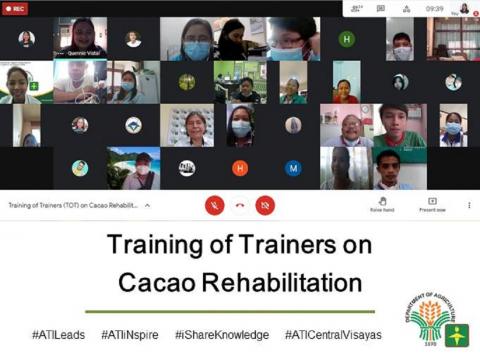Participants for the cacao rehabilitation training gather virtually to learn more on cacao farming
Central Visayas - The market opportunities, globally, for tablea and cocoa products are growing, as there are an increasing number of cafes and restaurants offering chocolate drinks. According to the 2017-2020 Philippine Cacao Industry Roadmap, the Philippines is said to be among the countries in Asia seen to have a competitive advantage on cacao production given its strategic location and climatic condition. Despite its advantage, the production of cacao in the Philippines remains low compared to the high demand.
In view of the current trend for the cacao industry, proper training must be provided to cacao farmers and appropriate production protocol should be observed. On 29 – 31 March 2021, a region-wide Training of Trainers on Cacao Rehabilitation was conducted virtually by the Agricultural Training Institute Regional Training Center VII . The training was completed by 27 agricultural extension workers (AEWs) and/or High Value Crops Development Program (HVCDP) technicians. Participants were from the different local government units of Bohol, Cebu and Negros Oriental.
The training aims to equip and enhance the knowledge, attitude and skills of AEWs/ HVCDP technicians on rehabilitation of unproductive and old cacao trees. In the course of the training, participants were taught about crop management in the rejuvenation of old and unproductive cacao trees and good agricultural practices. Further, they were also educated about cost and return analysis of cacao production.
“As an extension worker, we are the key agents in improving the produce especially in cacao farming. We should be equipped with knowledge or be knowledgeable in extending technical support to our farmers. Through this training, I have gained confidence in educating the farmers in our locality to further address the prevailing problems in cacao production,” said Christian Rabor, one of the participants.

